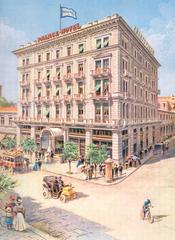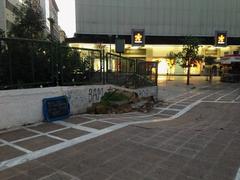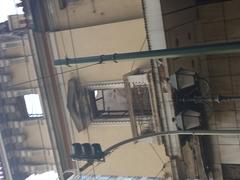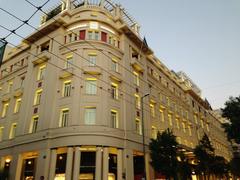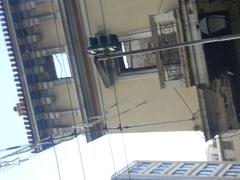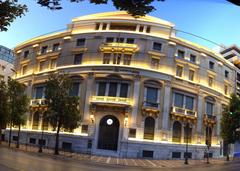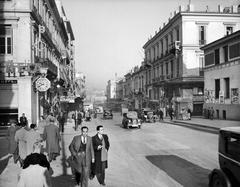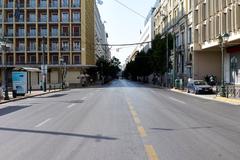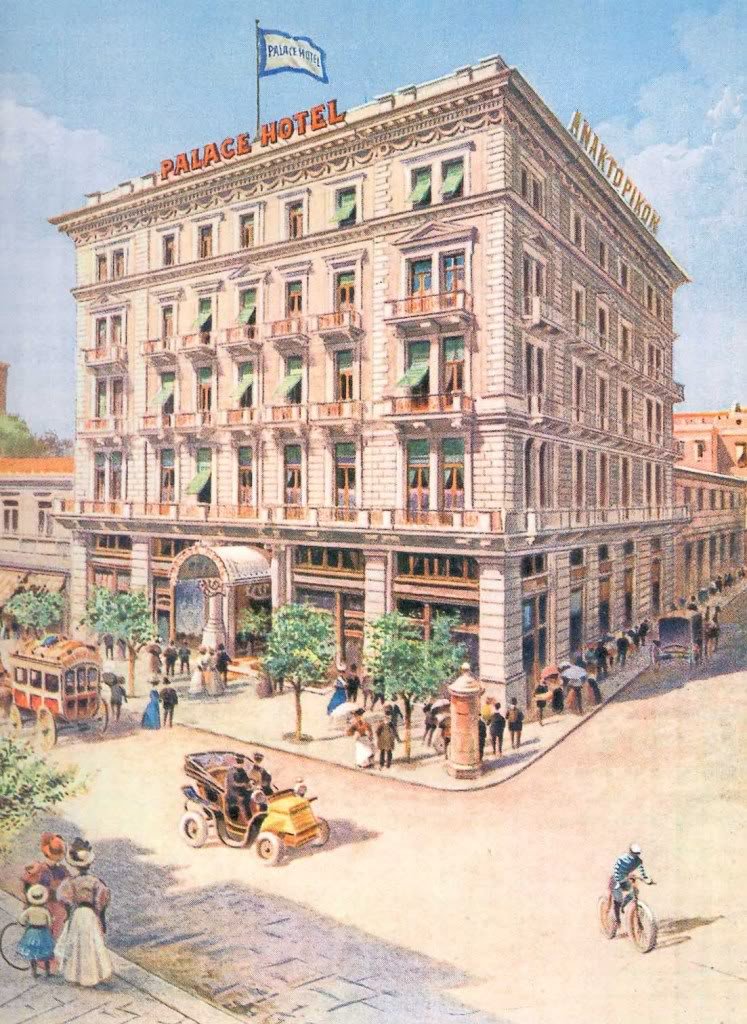
Stadiou Street Athens: Visiting Hours, Tickets, and Historical Sites Guide
Date: 14/06/2025
Introduction: The Heartbeat of Athens
Stadiou Street is one of Athens’ most emblematic avenues, weaving together the city’s storied past and vibrant present. Stretching from the historic Syntagma Square to the dynamic Omonia Square, Stadiou Street acts as both a vital thoroughfare and a living museum, presenting a blend of neoclassical grandeur, modern commercial life, and cultural landmarks. Originally intended to connect the city center with the ancient Panathenaic Stadium, the street’s development in the 19th century was emblematic of Athens’ transformation into the capital of an independent Greece. Today, Stadiou Street is not only a passage through Athens but an immersive experience into the city’s evolving identity (history-in-your-hands.com; athens24.com).
Accessible via multiple metro lines and public transportation links, Stadiou Street welcomes locals and visitors around the clock. Its sidewalks are lined with shops, cafes, arcades, and historical sites such as the Old Parliament House (now the National Historical Museum) and the iconic Bank of Greece. The avenue is also a focal point for cultural events and public gatherings, reflecting both the city’s traditions and its modern dynamism (thisisathens.org; nhmuseum.gr).
This guide provides all the essential information for exploring Stadiou Street: its history, main attractions, practical details on visiting hours and tickets, travel tips, accessibility, nearby sights, and insider advice for an enriching Athens experience (ekathimerini.com; bizness.gr).
Contents
- Historical Overview and Urban Evolution
- Architectural Highlights and Urban Development
- Economic Shifts and Recent Revitalization
- Main Landmarks and Cultural Sites
- Practical Information: Visiting Hours, Tickets, Accessibility
- Getting There and Around
- Recommended Nearby Attractions
- FAQs
Historical Overview and Urban Evolution
Stadiou Street’s roots trace back to the early 19th century, a period marked by Greece’s emergence as an independent nation. Named after the ancient Panathenaic Stadium, the original urban plan envisioned a direct link from the city center to this classical monument. Although financial constraints prevented the full execution of this vision, the name “Stadiou” (meaning “of the stadium”) endured as a testament to Athens’ ancient heritage (history-in-your-hands.com).
The current street took shape in the mid-19th century, coinciding with pivotal urban reforms. In 1860, the covering of the “Voidopnichti” stream transformed the landscape, laying the groundwork for Stadiou Street’s emergence as a central artery. Beneath its pavement, water continues to flow, a hidden link to its natural origins (athens24.com).
Throughout the late 19th and early 20th centuries, Stadiou Street became a showcase for neoclassical architecture. Elegant mansions and public buildings reflected the aspirations of the Athenian bourgeoisie. Notable examples include the Athinogenis Mansion and the Army Pension Fund building—today’s Citylink and Attica Department Store.
Architectural Highlights and Urban Development
Stadiou Street has witnessed several waves of transformation, each mirroring Athens’ broader socio-economic shifts. The introduction of streetcars and trolleys in the early 20th century cemented its role as a main transportation corridor. After World War II, the street evolved further, with neoclassical buildings giving way in part to modern office blocks and commercial spaces.
Despite extensive modernization, fragments of the city’s neoclassical legacy endure. The building at Stadiou 58 and Aiolou 103, dating from before 1885, is a protected example of 19th-century Athenian neoclassicism and is currently being redeveloped as a hotel, reflecting the ongoing effort to balance preservation with contemporary use (bizness.gr).
Economic Shifts and Recent Revitalization
Stadiou Street’s fortunes have fluctuated with Athens’ economic landscape. Once the city’s principal commercial artery, the street faced significant decline during Greece’s financial crisis in the 2010s, with many storefronts shuttered (ekathimerini.com). However, the last decade has brought ambitious revitalization projects: over €50 million has been invested in new hotels, office spaces, and the renovation of historic properties. Major developments include the transformation of old office buildings into LEED-certified hotels and the restoration of the Arsakeio Arcade into a food hall featuring Greek Mediterranean cuisine (tovima.com).
Main Landmarks and Cultural Sites
National Historical Museum (Old Parliament House)
Located at 13 Stadiou Street, this neoclassical landmark houses the National Historical Museum, featuring exhibits on the Greek War of Independence, political memorabilia, and a prominent statue of General Kolokotronis at its entrance.
- Visiting hours: Tuesday–Sunday, 8:30 AM–3:00 PM (closed Mondays)
- Tickets: €3 adults, free for EU citizens under 18 (nhmuseum.gr)
Bank of Greece
A symbol of national economic sovereignty, the Bank of Greece’s headquarters is another architectural highlight along Stadiou Street.
Kolokotronis and Klafthmonos Squares
These squares offer open space, public art, and a window into the civic life of Athens.
Historic Arcades (Stoa)
Stoa Pesmazoglou and other arcades are home to specialty shops, bookshops, and music stores, providing a unique blend of historic ambiance and modern retail.
Omonia Square
At the western end of Stadiou, Omonia Square is a historic meeting point, recently renovated and once again a lively urban hub.
The National Theatre of Greece
Located nearby on Agiou Konstantinou Street, this premier venue hosts classical and contemporary productions throughout the year (National Theatre Official Site).
Practical Information: Visiting Hours, Tickets, Accessibility
- Stadiou Street: Open to the public 24/7; no ticket required.
- Museums and Cultural Sites:
- National Historical Museum: Tuesday–Sunday, 8:30 AM–3:00 PM; ticket €3
- Bank of Greece Museum: Monday–Friday, 9:00 AM–2:00 PM; free admission
- Shops and Arcades: Generally open 9:00 AM–9:00 PM, with some shops extending to 8:00 PM.
- Accessibility: Wide, relatively flat sidewalks and ramps at intersections make the street accessible for wheelchairs and strollers. Some older buildings may have limited access.
- Transportation: Served by Syntagma, Panepistimiou, and Omonia metro stations; numerous bus and trolley lines (Athens Transport Authority).
- Safety: The area is generally safe during the day; exercise standard city precautions, especially near Omonia after dark.
Getting There and Getting Around
-
Public Transport:
- Metro: Syntagma (Lines 2 & 3), Omonia (Lines 1 & 2), Panepistimiou (Line 2)
- Buses and trolleybuses run along and near Stadiou Street
- Taxis and rideshares are widely available
-
On Foot:
- The street is pedestrian-friendly and connects easily to Ermou Street, Panepistimiou, and major city squares.
Recommended Nearby Attractions
- Syntagma Square: Political heart of Athens, site of the Hellenic Parliament and Changing of the Guard.
- Athens Trilogy: The Academy, University, and National Library, exceptional neoclassical buildings on nearby Panepistimiou Street.
- Omonia Square: Recently renovated urban hub and transport interchange.
- Plaka, Monastiraki, and Psiri: Colorful neighborhoods with markets, dining, and nightlife, all within a short walk.
- Panathenaic Stadium: Approximately 3 km southeast; easily reached via public transport or a pleasant walk.
Travel Tips and Insider Advice
- Best Time to Visit: Spring (April–May) and autumn (September–October) for mild weather and fewer crowds.
- Food & Drink: Enjoy Greek coffee at a traditional café or sample local street food from vendors along Stadiou Street.
- Shopping: Visit Attica department store and the arcades for a mix of international and local brands.
- Guided Tours: Book in advance for themed walking tours focusing on history, architecture, or contemporary culture.
- Photography: Early morning and sunset offer the best light for capturing the street’s architectural features.
Frequently Asked Questions (FAQ)
Q: Do I need tickets to walk on Stadiou Street?
A: No, walking along Stadiou Street is free.
Q: What are the opening hours for the National Historical Museum?
A: Tuesday–Sunday, 8:30 AM–3:00 PM; closed Mondays.
Q: Are there guided tours available?
A: Yes, numerous walking tours include Stadiou Street. Check with local agencies or thisisathens.org.
Q: Is Stadiou Street accessible for wheelchairs?
A: The street is mostly accessible, but some older buildings may have limited facilities.
Q: What’s the best way to get there?
A: Via metro (Syntagma, Panepistimiou, or Omonia stations) or by walking from nearby neighborhoods.
Conclusion
Stadiou Street is more than a mere city artery—it is a vibrant showcase of Athens’ history, resilience, and modern energy. From neoclassical landmarks and lively arcades to contemporary renovations and cultural events, it invites every visitor to experience the true spirit of the Greek capital.
For the latest updates on events, guided tour bookings, and insider recommendations, download the Audiala app and follow our social media channels. Let Stadiou Street be the starting point for your Athens adventure.
Visuals and Interactive Elements
- High-resolution images of the Old Parliament House, neoclassical façades, and modern hotel renovations (with alt tags such as “Stadiou Street neoclassical architecture” and “National Historical Museum on Stadiou Street”).
- Interactive map highlighting key landmarks, metro stations, and recommended photo spots.
- Links to virtual tours and additional media resources for further exploration.
Internal and External Resources
Internal Links:
- [Athens historical sites]
- [Syntagma Square attractions]
- [Walking tours in Athens]
External Links:
Sources
- Discovering Stadiou Street: Athens’ Historic Heart and Visitor’s Guide, 2025, History In Your Hands (history-in-your-hands.com)
- Stadiou Street Athens Guide, 2025, Athens24 (athens24.com)
- New Lease of Life for Stadiou Street, 2025, Ekathimerini (ekathimerini.com)
- The 4 Major Real Estate Projects Transforming Stadiou Street in the Centre of Athens, 2025, Bizness (bizness.gr)
- Major Projects Aim to Restore Athens’ Iconic Commercial Hub, 2025, To Vima (tovima.com)
- Athens Official Tourism Website, 2025, This is Athens (thisisathens.org)
- National Historical Museum Official Site, 2025 (nhmuseum.gr)
